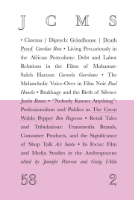
JCMS-Journal of Cinema and Media Studies
Scope & Guideline
Exploring the Intersection of Cinema and Society
Introduction
Aims and Scopes
- Interdisciplinary Media Analysis:
The journal engages with various media forms, including film, television, and digital platforms, analyzing their cultural implications and historical significance. - Cultural and Political Critique:
Research often addresses the intersections of media with race, gender, sexuality, and colonialism, highlighting how these factors shape media narratives and audience reception. - Global Perspectives:
A commitment to exploring media from a global perspective, examining how local practices influence and are influenced by global trends in cinema and media. - Historical Contextualization:
The journal emphasizes the importance of historical context in understanding contemporary media practices, often revisiting archival materials and historical filmic texts. - Emerging Media Technologies:
Research includes analysis of new media technologies and their impact on traditional film and media practices, exploring how digitalization is reshaping the landscape.
Trending and Emerging
- Media and Activism:
There is a rising trend in examining the relationship between media and activism, particularly how film and digital platforms serve as tools for social change and political engagement. - Queer and Trans Studies:
An increasing focus on queer and trans studies showcases the journal's commitment to exploring diverse sexualities and gender identities within media representations. - Global and Transnational Studies:
Research addressing transnational cinema and media illustrates a growing interest in how global flows of culture challenge and reshape local narratives and identities. - Environmental Media Studies:
Emerging themes in environmental media studies reflect an increasing concern with ecological issues, examining how media influences public perceptions of climate change and sustainability. - Digital and New Media Critique:
The journal is increasingly publishing analyses of digital media, including social media platforms, streaming services, and their impact on audience engagement and cultural consumption.
Declining or Waning
- Traditional Film Criticism:
There appears to be a waning interest in strictly traditional film criticism, as the journal increasingly prioritizes interdisciplinary approaches that incorporate broader cultural and social analyses. - Mainstream Hollywood Narratives:
Research centered on mainstream Hollywood narratives is less frequently featured, suggesting a shift towards more diverse and underrepresented media forms rather than conventional blockbuster cinema. - Static Gender Roles in Media:
Discussions surrounding static gender roles in media are declining, as the journal moves towards more nuanced explorations of gender fluidity and intersectionality in contemporary media. - Historical Biographies of Filmmakers:
While historical analyses remain vital, there is a noticeable decrease in papers focused on individual filmmakers' biographies, indicating a preference for thematic and collective studies. - Classic Genre Studies:
Research focused on classic film genres is becoming less prominent, as the journal explores more innovative and hybrid media forms that cross traditional genre boundaries.
Similar Journals
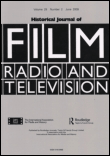
HISTORICAL JOURNAL OF FILM RADIO AND TELEVISION
Advancing Scholarship in Film, Radio, and Television StudiesHISTORICAL JOURNAL OF FILM RADIO AND TELEVISION, published by Routledge Journals, Taylor & Francis Ltd, is a leading academic publication that explores the intricate narratives of film, radio, and television throughout history. With an ISSN of 0143-9685 and an E-ISSN of 1465-3451, this journal has established itself as a vital resource for researchers and professionals within the fields of communication, history, and the visual arts, reflecting its commitment to rigorous scholarship since its inception in 1981. The journal occupies a reputable position in the academic landscape, recently categorized as Q4 in Communication and History, and Q3 in Visual Arts and Performing Arts, indicating its relevance in these fields. Despite the absence of Open Access options, the publication remains accessible to institutions and individuals eager to engage with critical analyses and historical perspectives on visual media. With its broad scope and historical emphasis, the HISTORICAL JOURNAL OF FILM RADIO AND TELEVISION is crucial for understanding the evolution of media and its impact on culture, making it an essential read for scholars and practitioners alike.

MILLENNIUM FILM JOURNAL
Exploring the Depths of Cinema's Cultural Tapestry.MILLENNIUM FILM JOURNAL, published by MILLENNIUM FILM WORKSHOP INC, stands as a pivotal platform for exploration and discourse within the realm of film studies. With its ISSN 1064-5586, the journal has been noteworthy in delineating the complexities of visual arts and performing arts, contributing significantly to academic scholarship between the years 2009 to 2016, and in 2018. Though its coverage has been discontinued in Scopus, the journal has attained a respectable position within its category, ranking #320 out of 502 in the Arts and Humanities field. Researchers, professionals, and students alike are invited to engage with interdisciplinary discussions that illuminate the cultural and theoretical dimensions of cinema. While currently not offering open access options, the journal continues to serve as a vital resource for those deeply invested in the study of film, making it a respected voice in visual arts and performance research.
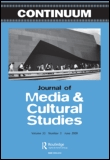
Continuum-Journal of Media & Cultural Studies
Cultivating scholarly excellence in media discourse.Continuum-Journal of Media & Cultural Studies, published by Routledge Journals, Taylor & Francis Ltd, stands as a premier platform for scholarly discourse in the fields of media studies, cultural studies, visual arts, and performing arts. With an impressive Q1 ranking in both Cultural Studies and Visual Arts and Performing Arts for 2023, this journal exemplifies scholarly excellence, attracting high-impact research and innovative ideas that contribute significantly to the academic community. The journal does not currently offer open access, but its rigorous peer-review process ensures that published articles maintain the highest standards of academic integrity and relevance. With a comprehensive coverage period from 1980 to 2024, Continuum addresses critical issues and explores diverse methodologies, making it an essential resource for researchers, professionals, and students alike. Whether you're looking to deepen your understanding of contemporary cultural dynamics or seeking to share your research with a discerning audience, Continuum provides a vital space for transformative dialogue and engagement.
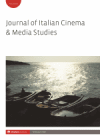
Journal of Italian Cinema and Media Studies
Illuminating the Intersections of Film, Culture, and SocietyThe Journal of Italian Cinema and Media Studies, published by INTELLECT LTD, is a premier academic journal dedicated to the exploration and critical analysis of Italian cinema and media. Since its inception in 2013, the journal has contributed significantly to the discourse surrounding the intersections of film, culture, and society, making it a vital resource for researchers and professionals alike. With an impressive span of converged years through 2024 and categorized in various quartiles, such as a Q1 ranking in Visual Arts and Performing Arts, the journal stands out in its field. Although it does not currently offer open access, the rigorous scholarship it publishes is accessible to a wide audience, contributing to ongoing dialogues in communication and cultural studies. The journal's impact is further reflected in its Scopus rankings, positioning it within the 64th percentile in Visual Arts and Performing Arts and the 21st percentile in Communication. As a critical avenue for scholarly exchange and creative inquiry, the Journal of Italian Cinema and Media Studies is essential for anyone engaged in the study of media, culture, and the arts.
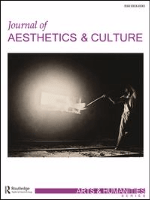
Journal of Aesthetics & Culture
Engaging Perspectives on Aesthetic ExperienceJournal of Aesthetics & Culture, published by TAYLOR & FRANCIS LTD, is a prestigious Open Access journal that has been serving the academic community since its inception in 2009. Based in the United Kingdom, this journal aims to explore, document, and critically engage with themes in Cultural Studies, Philosophy, and the Visual and Performing Arts. Notable for its impact, the journal holds a Q3 ranking in Cultural Studies and Philosophy, and a Q2 ranking in Visual Arts and Performing Arts as of 2023. With its Scopus rankings placing it within the top 17% of Visual Arts and Performing Arts journals and top 31% in Philosophy, it stands as a vital resource for researchers and practitioners alike. Covering a broad range of contemporary issues and inviting innovative perspectives, the Journal of Aesthetics & Culture plays a crucial role in shaping critical discourse within its fields and fostering an understanding of the intricate interplay between aesthetics and societal contexts.
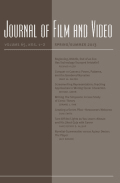
JOURNAL OF FILM AND VIDEO
Cultivating Critical Discourse in the Visual ArtsThe JOURNAL OF FILM AND VIDEO, published by University of Illinois Press, is a pivotal academic platform that delves into the intricate intersections of film, video, and media studies. With a notable ISSN of 0742-4671 and E-ISSN 1934-6018, this journal has established itself as a significant contributor to the visual arts and performing arts field, currently positioned in Q3 of its category as per the 2023 quartiles. Spanning from 2002 to 2024, it presents a comprehensive array of research, critiques, and theoretical discussions that advance scholarly discourse in film and video. The journal encourages contributions that explore innovative narratives and methodologies, catering to a diverse readership of researchers, professionals, and students alike. While it maintains a traditional subscription model and is not open access, its impact is amplified through its Scopus ranking, holding the 323rd position out of 667 in the visual arts and performing arts category. With its commitment to fostering critical conversations and promoting scholarly excellence, the JOURNAL OF FILM AND VIDEO remains an essential resource for those invested in the study and understanding of film and media.

Journal of African Media Studies
Navigating the Intersection of Media and Society in Africa.Journal of African Media Studies, published by INTELLECT LTD, stands at the forefront of communication research, focusing on the rich tapestry of media practices and theories across the African continent. Since its inception in 2011, this peer-reviewed journal has dedicated itself to exploring the intricate relationships between media, culture, and society in Africa, contributing significantly to the global discourse on communication. With an impressive impact factor positioning it in Q2 of the Communication category for 2023, and ranking #218 out of 511 in the Scopus Social Sciences Communication field, it offers a rigorous platform for scholars and practitioners alike. The journal's commitment to quality research is evident in its robust editorial process and its regular publication of articles that delve into contemporary issues affecting African media landscapes. Despite being a subscription-based journal, it attracts an engaged readership interested in accessing critical insights and advancing knowledge in media studies. As it converges its timeline towards 2024, Journal of African Media Studies continues to be an essential resource for researchers, professionals, and students eager to contribute to and explore the evolving narratives of African media.

Transnational Screens
Advancing Interdisciplinary Dialogues on Global Artistic PracticesTransnational Screens is a premier academic journal published by Taylor & Francis Ltd, focusing on the dynamic intersections of visual arts, performing arts, and communication in a globalized context. Since its inception, the journal has garnered significant recognition, featuring in the Q1 category for Visual Arts and Performing Arts and Q3 for Communication as of 2023, reflecting its influential contributions to these fields. With a Scopus ranking placing it in the 78th percentile in Visual Arts and Performing Arts, this journal serves as a vital platform for researchers, professionals, and students aiming to explore the implications of transnational narratives in contemporary media and artistic practices. The journal is accessible to a diverse readership and promotes open dialogue through its commitment to publishing innovative and interdisciplinary research from 2020 to 2024. As a key resource for understanding the complexities of transnational screens, it invites submissions that push the boundaries of traditional scholarship and engage with pressing global issues through the lens of the visual and performing arts.

FILM QUARTERLY
Unveiling Insights in Film StudiesFilm Quarterly, published by University of California Press, stands as a leading academic journal in the field of visual arts and performing arts, boasting a prestigious Q1 ranking in the 2023 category quartiles. Since its inception in 1969, this quarterly publication has made significant contributions to the study and critique of cinema, attracting attention for its insightful articles, cutting-edge research, and comprehensive reviews that appeal to scholars, practitioners, and students alike. With an ISSN of 0015-1386 and an E-ISSN of 1533-8630, it serves as an essential resource for those seeking to enhance their understanding of film theory, history, and analysis. Although not open access, its articles are critical for researchers navigating the complex landscape of contemporary and historical film studies, underscoring its vital role in advancing scholarship within the discipline.
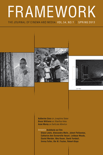
Framework-The Journal of Cinema and Media
Engaging with contemporary debates in film.Framework: The Journal of Cinema and Media is a prominent academic journal published by Wayne State University Press, focusing on the dynamic fields of cinema studies and media theory. With an ISSN of 0306-7661 and an E-ISSN of 1559-7989, it serves as a key platform for researchers, professionals, and students to explore critical issues in media culture, film theory, and the intersection of digital technologies and narrative. Although it does not currently offer open access, the journal maintains a reputation for rigorous scholarship and thought-provoking content, providing insights that challenge conventional understandings of media and its impact on society. Published in Detroit, MI, Framework continues to engage with contemporary debates and innovative practices in cinema and media, making it an essential resource for those dedicated to advancing research in these vibrant disciplines.